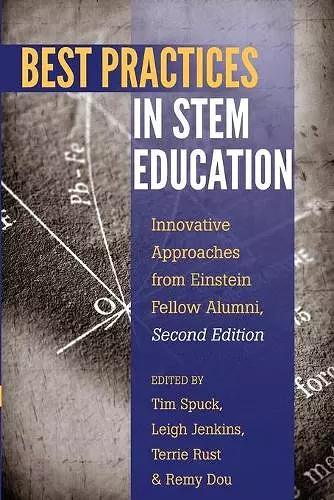Best Practices in STEM Education
Innovative Approaches from Einstein Fellow Alumni, Second Edition
Greg S Goodman editor Tim Spuck editor Leigh Jenkins editor Terrie Rust editor Remy Dou editor M Cathrene Connery editor
Format:Paperback
Publisher:Peter Lang Publishing Inc
Published:21st Nov '18
Currently unavailable, and unfortunately no date known when it will be back
This paperback is available in another edition too:
- Paperback£43.95(9781433121944)

Science, technology, engineering, and mathematics (STEM) education are seen by leaders from across the globe as key to economic success and prosperity. The goal of Best Practices in STEM Education: Innovative Approaches from Einstein Fellow Alumni, Second Edition is to improve the state of STEM education, not only in the United States, but internationally as well—good education anywhere is good for education everywhere. As the body of STEM-learning research grows, this second volume provides the unique perspective of nationally recognized educators who have spent, collectively, more than 600,000 hours at the interface between teaching and learning. The 24 chapters included in this volume are the product of years of practice, mistakes, reflection, and refinement. They provide the experiential pragmatism backed by research so desired by practitioners. Each chapter communicates how its author has implemented a specific STEM practice in the classroom and how the practice might be modified for use in other classrooms, schools, and learning environments. These are stories of success, as well as stories of struggle. Readers of this second edition will gain powerful insight about what really works when it comes to teaching and learning STEM.
Best Practices in STEM Education: Innovative Approaches from Einstein Fellow Alumni, Second Edition will serve as an excellent resource for use in any science, technology, engineering, and mathematics teaching methods course, and no professional education library, K through college, should be without a copy
“This STEM publication with chapters prepared by young theoreticians and practitioners of STEM pedagogical knowledge is a seminal work. The diversity of topics for the effective involvement of all youth in the structure of science makes this publication a necessary resource in all schools. This is a very significant contribution to STEM education.”—H. Prentice Baptiste, Regents and Distinguished Professor, New Mexico State University; President, National Association for Multicultural Education
“Broad implementation of these best practices has the potential to improve STEM education both here in the United States and across the globe.”—U.S. Congressman Mike Honda
“This STEM publication with chapters prepared by young theoreticians and practitioners of STEM pedagogical knowledge is a seminal work. The diversity of topics for the effective involvement of all youth in the structure of science makes this publication a necessary resource in all schools. This is a very significant contribution to STEM education.”—H. Prentice Baptiste, Regents and Distinguished Professor, New Mexico State University; President, National Association for Multicultural Education
“STEM teachers, this book is for you. You’ll catch glimpses of your future self in these stories. They’re not about rocket science—they’re about deep commitment to students’ thinking and learning.”—Colleen Megowan-Romanowicz, Senior Fellow, American Modeling Teachers Association
“Save yourself some time and buy two copies right away; you’ll surely want to give one of your copies to a colleague.”—Stephen Pompea, National Optical Astronomy Observatory
“This book is STEM for the 21st century!”—Sarah Young, Utah State Office of Education
“This book could not come at a more critical time, considering our country’s dire STEM workforce needs.”—Cindy L. Hasselbring, Maryland State Department of Education
“STEM teachers, this book is for you. You’ll catch glimpses of your future self in these stories. They’re not about rocket science—they’re about deep commitment to students’ thinking and learning.”—Colleen Megowan-Romanowicz, Senior Fellow, American Modeling Teachers Association
“Provides concrete examples to bring STEM alive in the classroom.”—Ioannis Miaoulis, Museum of Science, Boston
“A useful guide to educators who seek STEM clarity in the form of practices that can be readily adopted in their own classrooms or informal learning settings.”—Tom Peters, South Carolina Coalition for Mathematics and Science
“Highly recommended for any educator seeking proven practices from some of our nation’s best STEM educators.”—DaNel Hogan, STEM Coordinator, Office of Pima County School Superintendent
ISBN: 9781433154164
Dimensions: unknown
Weight: 872g
584 pages
2nd Revised edition